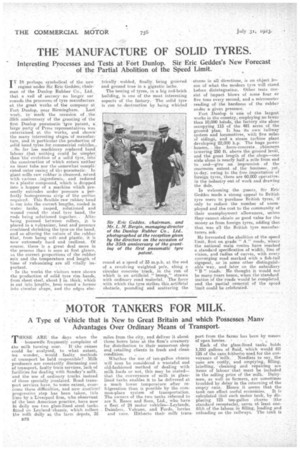THE MANUFACTURE OF SOLID TYRES.
Page 12

If you've noticed an error in this article please click here to report it so we can fix it.
Interesting Processes and Tests at Fort Dunlop. Sir Eric Geddes's New Forecast of the Partial Abolition of the Speed Limit.
IT IS perhaps symbolical of the new
. regime:under Sir Eric Geddes; chairman of the Dunlop Rubber (Jo., Ltd., that A -veil of •Secreey: no lenger sur rounds the processes-of tyre manufacture. at the great works of the company at Fort Dunlop, near Birmingham. . Last. week, to' mark the occasion of , the. 35ili anniversary of the granting of the first Dunlop -pneumatic 'tyre patent, large party of -Press -representatives was entertained at the works, and shown the many interesting stages of manufacture, and in particular. the.produCtion of solid hand tyresfor commercial vehicles.) farhas machinery replaced hand labour ,that..-nothing could be simpler; than -the' eVolation of a solid tyre,into the constrtiction of which enters neither' an inner tube nor the somewhat •compli.-cited outer easing of the.pneuthatie,• In giant mills raw rubber is cleansed, mixed with various :ingredients, and reduced to a plastic compound, which is dropped into a hopper of a machine which presently extrudes under 'pressure a perfectly homogeneous strip of the section required. This flexible raw robber band is eat into the correct lengths, cooled in water tanks, rasped, solutioned and wound round tin_ steel -tyre band, the ends being solutioned together. , After being pressed between rollers, it is placed in a vulcanizer, heat and • pressure combined shrinking the tyre on the band, end so altering the nature of the rubber that, from being softand plastic, it is now extremely hard and resilient. Of course. there is a great deal more in the process than is seems at first glance, as the correct proportions of the rubber mix and the .temperature and length of time of vulcanizing are all vitally im
portant. • ;
In the works the visitors were shown the production of solid tyre rim. bands, from sheet steel, about fn. thick, which is cutinto.lengths, .bent. round a former into circular shape, and the edges elec
trically . welded, finally being grooved and ground true in a gigantic lathe.
The testing of tyres, in a big red-brick huilding, is one of the most interesting aspects of the factory. The solid tyre is run to destruction by being whirled round at a speed of 33 m.p.h. at the end of a revolving weighted pole, along a circular concrete track, in the •run of which is an artificial " trump," strewn with Ordinary road material. The force with which the tyre strikes this artificial obstacle, pounding and scattering the stones in all directions, is an object lesson of what the modern tyre will stand. before disintegration. Other tests consist of impact blows of some four or five tons every second, and a micrometer reading ofthe hardness of the rubber under a given pressure.
Fort Dunlop is one of the largest works in the country, employing no fewer than 10,000 hduds, the factory site alone occupying 115 of the 481 acres of the ground plan. It has its own' railway system and locomotives, with five miles of sidings, and a steam turbine plant developing 22,000 h.p. The huge power houses; . the ferro-concrete.. chimneys towering 259 ft. above the greturd level, and the great length of the shops—one aisle-slone is nearly half a mile from end to _end—give an . impression of the enormous extent of the business, yet, to-day, owing to the free importation of foreign tyres, there are 60,090 operative: in the industry out of work and drawing the dole.
• In welcoming the guests, Sir Eric Geddes made a strong appeal to British tyre users to purchase British tyres, if only to reduce the number of unemployed and the cost to the community of their unemployment allowances, unless they cannot obtain as good value for the money -as from foreign tyres, adding that that was all the British tyre mannfacturers ask.
He forecasted the abolition of the speed limit, first on grade " A " roads, where the national main routes have reached a standard specification of width, lino of vision, and radius of curves, with every converging road marked with a fish-tail signpost, or in some other distinguishable way, and later on the subsidiary " B " roads. He. thought it would not be many years hence, when the standard. ization of the roadswould be completed. and the partial removal of the spt,ed limit could be Celebrated.






























